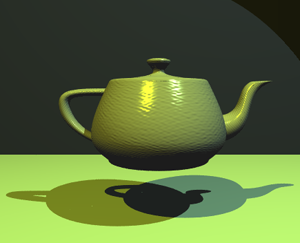Utah teapot

The Utah teapot or Newell teapot is a 3D model which has become a standard reference object (and something of an in-joke) in the computer graphics community. It is a mathematical model of an ordinary teapot of comparatively simple shape, which appears solid, cylindrical and partially convex.
The teapot model was created in 1975 by early computer graphics researcher Martin Newell, a member of the pioneering graphics program at the University of Utah.
History
Newell needed a moderately simple mathematical model of a familiar object for his work. Sandra Newell (his wife) suggested modelling their tea service since they were sitting down to tea at the time. He got some graph paper and a pencil, and sketched the entire tea service by eye. Then, he went back to the lab and edited bézier control points on a Tektronix storage tube, again by hand.

The teapot shape contains a number of elements that made it ideal for the graphics experiments of the time — it is round, contains saddle points, has a genus greater than zero because of the hole in the handle, can project a shadow on itself, and looks reasonable when displayed without a complex surface texture.
Newell made the mathematical data that describes the teapot's geometry (a set of three-dimensional coordinates) publicly available, and soon other researchers began to use the same data for their computer graphics experiments. These researchers needed something with roughly the same characteristics that Newell had, and using the teapot data meant they did not have to laboriously enter geometric data for some other object. Although technical progress has meant that the act of rendering the teapot is no longer the challenge it was in 1975, the teapot continued to be used as a reference object for increasingly advanced graphics techniques.
Over the following decades, editions of computer graphics journals (such as the ACM SIGGRAPH's quarterly) regularly featured versions of the teapot: faceted or smooth-shaded, wireframe, bumpy, translucent, refractive, even leopard-skin and furry teapots were created.
The original teapot model was never intended to be seen from below and had no surface to represent the base of the teapot; later versions of the data set have fixed this.
The real teapot is noticeably taller than the computer model because Newell's frame buffer used non-square pixels. Rather than distorting the image, Newell's colleague Jim Blinn reportedly scaled the geometry to cancel out the stretching, and when the model was shared with users of other systems, the scaling stuck. Height scale factor was 1.3.
The original, physical teapot was purchased from ZCMI (a department store in Salt Lake City, Utah) in 1974. It was donated to the Boston Computer Museum in 1984 where it was on display until 1990. It now resides in the ephemera collection at the Computer History Museum in Mountain View, California where it is catalogued as "Teapot used for Computer Graphics rendering" and bears the catalogue number X00398.1984.
Versions of the teapot model, or sample scenes containing it, are distributed with or freely available for nearly every current rendering and modelling program and even many graphic API, including AutoCAD, Houdini, Lightwave 3D, modo, POV-Ray, 3D Studio Max, and the API's OpenGL and Direct3D. Some RenderMan-compliant renderers support the teapot as a built-in geometry by calling RiGeometry("teapot", RI_NULL). Along with the expected cubes and spheres, the GLUT library even provides the function glutSolidTeapot() as a graphics primitive, as does its Direct3D counterpart D3DX (D3DXCreateTeapot()). Mac OS X Tiger and Leopard also include the teapot as part of Quartz Composer, Leopard's teapot supports bump mapping. BeOS included a small demo of a rotating 3D teapot, intended to show off the platform's multimedia facilities.
Teapot scenes are commonly used for renderer self-tests and benchmarks. In particular, the Teapot in a stadium benchmark and problem concern the difficulty of rendering a scene with drastically different geometrical density and scale of data in various parts of the scene.[1][2]
Appearances
With the advent first of computer generated short films, and then of full length feature films, it has become something of an in-joke to hide a Utah teapot somewhere in one of the film's scenes.[3] For example, in the movie Toy Story the Utah teapot appears in a short tea-party scene. The Utah teapot sometimes appears in the "Pipes" screensaver shipped with Microsoft Windows.[4] The teapot also appears in The Simpsons episode Treehouse of Horror VI.[5]
One famous ray-traced image (by Jim Arvo and Dave Kirk, from their 1987 SigGraph paper "Fast Ray Tracing by Ray Classification") shows six stone columns five of which are surmounted by the platonic solids (tetrahedron, cube, octahedron, dodecahedron, icosahedron) - and the sixth column has a teapot[6]. The image is titled "The Six Platonic Solids" - which has led some people to call the teapot a "Teapotahedron". This image appeared on the covers of several books and journals. Jim Blinn (in one of his "Project Mathematics!" videos) proves an interesting version of the Pythagorean theorem: Construct a (2D) teapot on each side of a right triangle and the area of the teapot on the hypotenuse is equal to sum of the areas of the teapots on the other two sides.
The Newell Teapot is also used on the Serious Sam game to show the 3D modeling properties of the Serious engine.
See also
- Virtual model
- Trojan room coffee pot
- Stanford Bunny
- Stanford Dragon
- Lena Soderberg/Lenna
- Cornell Box
- Hello World
References
- ^ Ingo Wald, Carsten Benthin, and Philipp Slusallek. "A Simple and Practical Method for Interactive Ray Tracing of Dynamic Scenes". Technical report, Computer Graphics Group, Saarland University, 2002., CiteSeer:[1]
- ^ Krzysztof S. Klimaszewski, Thomas W. Sederberg, "Faster Ray Tracing Using Adaptive Grids", IEEE Computer Graphics and Applications Vol. 17 , Issue 1 (1997)
- ^ Tempest in a Teapot, Continuum Magazine, Winter 2006/2007
- ^ "Pipes" screensaver spec
- ^ Pacific Data Images on Homer³
- ^ A Critical History of Computer Graphics and Animation
